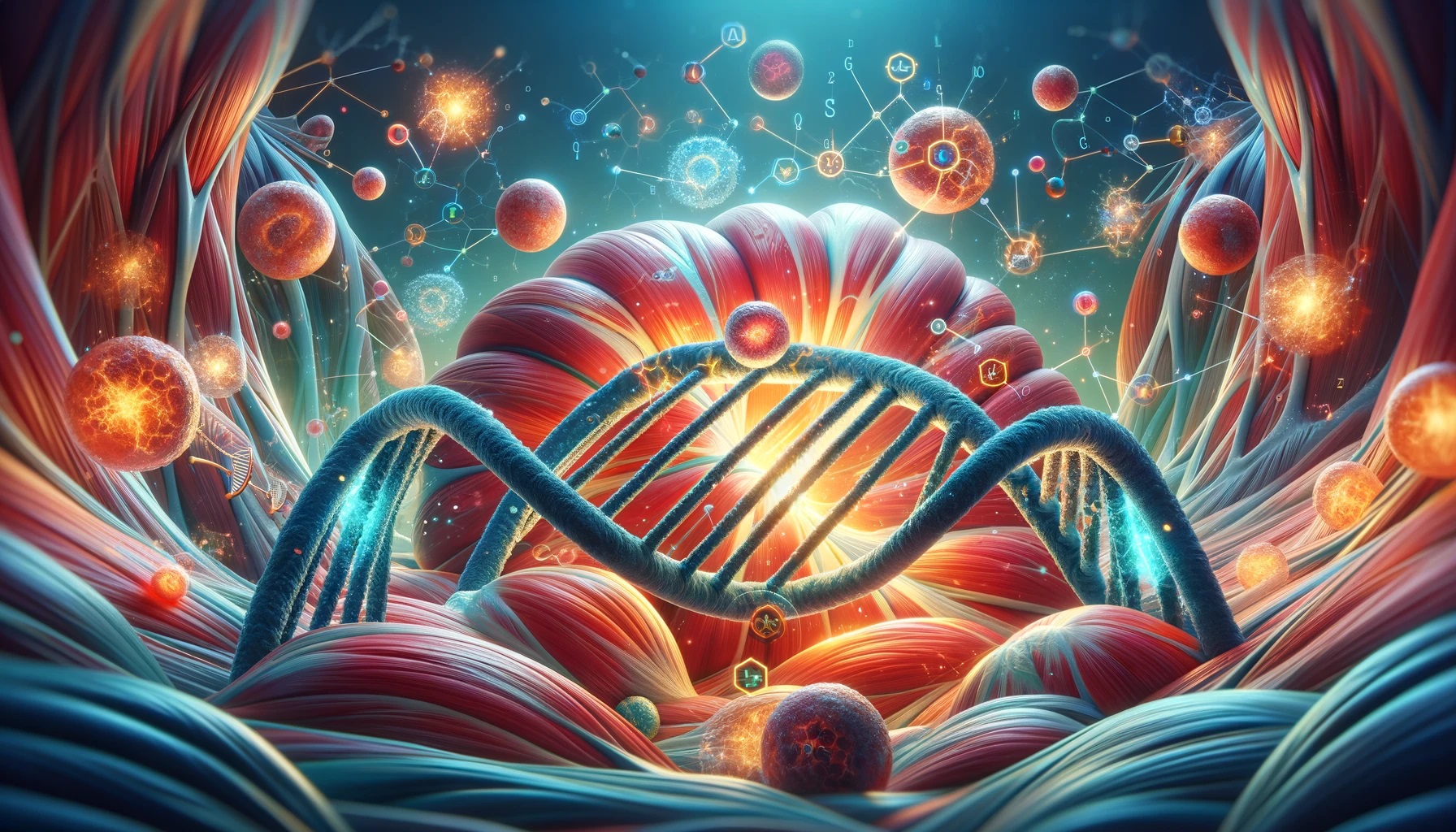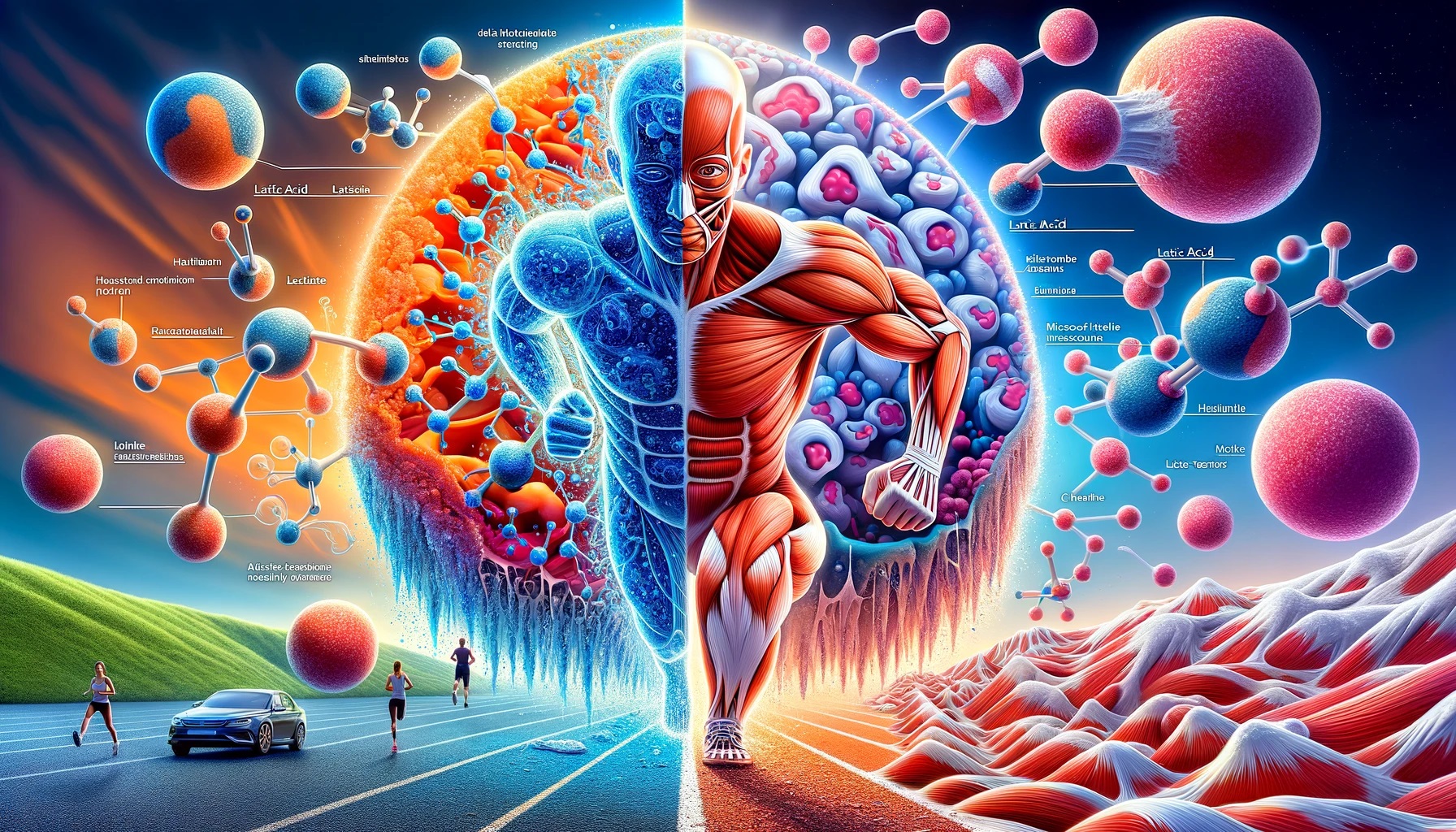· fitness · 16 min read
Unveiling the Secrets: How Muscle Memory Transcends Neural Pathways
Explore the groundbreaking discovery of muscle memory beyond neural networks, delving into its cellular mechanisms and implications for fitness and rehabilitation.

In This Post
The Fact Why Should I Care How To Put In Action Start Tomorrow Guide How does it effect my ability to focus How does it impact my daily life How does it help me make friends How does it help me manage stress How does it effect my mood Summary: Remember Refresher Checklist The Full Research Article CitationsPrint Out The Tomorrow Checklist!
Sign up for our newsletter and receive a copy today, so that, you can start tomorrow! Or the next day, or the day after that. I forget everything and starting things is hard at least for me so these checklists are godsend.
Print Out The Remember Refresher Checklist!
Sign up for our newsletter and download your own copy of the Remember Refresher Checklist, so that, you can easily put it on your fridge and help you stay on target towards your WHY. Every little bit helps.
Introduction to Muscle Memory
Understanding Muscle Memory: Beyond the Neural Network
Muscle memory is a term that has been broadly utilized within the realm of fitness and rehabilitation to describe how our bodies remember certain motor actions. Traditionally, the concept was confined to the understanding of neural pathways, the connections within our brain and nervous system that become more efficient with repetition. However, recent advancements in the field of exercise physiology have illuminated a much deeper, cellular basis of muscle memory.
This intriguing cellular perspective of muscle memory sheds light on how physical training and exercise not only enhance the coordination and efficiency of our motor actions through neural adaptations but also induce lasting changes at the cellular and molecular levels within our muscles themselves. These changes enhance the muscle’s ability to regenerate, grow, and adapt to physical demands, demonstrating a remarkable capacity for memory that transcends mere neural pathways.
- Neural network adaptations through repetitive training
- Cellular and molecular changes in muscles
- Enhanced muscle regeneration and growth
- Increased adaptability to physical demands
The Revolutionary Discovery: Muscle Memory at the Cellular Level
The pivotal shift in understanding muscle memory came with the discovery of its existence at the cellular level. Scientists have now confirmed that muscle cells themselves can “remember” previous encounters with stress, such as exercise or resistance training. This discovery was groundbreaking because it signified that muscle memory is not only a product of brain or neural memory but also a fundamental cellular mechanism.
This cellular memory is facilitated through various biological processes, including DNA methylation and RNA synthesis. These processes lead to lasting epigenetic changes within muscle cells, allowing them to adapt quicker and more robustly to familiar physical stresses in the future. Such cellular level adaptations pave the way for rapid re-acquisition of muscle strength and mass after periods of inactivity, also known as the “use it or lose it, but can quickly get it back” phenomenon.
- Discovery of muscle memory at the cellular level
- DNA methylation and RNA synthesis as key processes
- Epigenetic changes enabling quick readaptation to physical stresses
- Enhanced recovery of muscle strength and mass after inactivity
The introduction of muscle memory from a cellular and molecular standpoint offers a fresh perspective on the body’s remarkable adaptability. It propels us to delve deeper into Part 2, where we unravel the science behind this fascinating phenomenon, highlighting the roles of RNA, strength training, and epigenetic changes in the retention and re-acquisition of muscular strength and endurance.
The Science Behind Muscle Memory
Muscle Memory: An Overview of Traditional Beliefs
Muscle memory has long fascinated athletes, coaches, and scientists alike. Traditionally, it’s been understood primarily within the frame of neural pathways and motor learning. This concept suggests that with repetition, movements become more automatic due to the strengthening of neural connections in the brain. These traditional beliefs have underscored the importance of consistent practice in developing skill proficiency and physical strength. It’s been thought that through diligent training, our body and mind establish a “memory” of the action, making it easier to perform over time without conscious effort.
Breaking New Ground: How Recent Research Shifts Our Understanding
However, recent advancements in exercise physiology and cellular biology are revolutionizing our understanding of muscle memory. Scientists are now uncovering evidence that suggests muscle memory extends beyond the neural networks and deep into our muscles’ cellular structure. This new wave of research indicates that muscles might possess their own form of memory, capable of recording past exercise experiences. Such findings hint at a complex interplay between our cells and training habits, potentially explaining why regaining muscle strength after a period of inactivity seems easier for those who have trained before. This opens up new questions and insights into how long-term fitness and strength training adaptations occur on a cellular level.
The Role of RNA in Muscle Memory Retention
A critical player in this cellular memory paradigm is RNA, particularly its role in mediating the effects of exercise on muscle adaptation. Muscle memory at the cellular level might be influenced by:
Skeletal muscle adaptation: Through resistance training, skeletal muscles undergo changes, inducing muscle hypertrophy. This process is not merely a physical enlargement of the muscle but involves a complex cellular reaction that includes increased RNA synthesis and protein synthesis in muscles.
Epigenetic changes: Exercise induces epigenetic modifications, such as DNA methylation in muscle cells, impacting gene expression over time. These changes can act as a cellular record of past exercise, affecting how muscles respond to future training.
RNA synthesis acceleration: During and after exercise, there’s an increase in RNA synthesis within muscle cells. This boosts protein synthesis, essential for muscle repair and growth. It’s suggested that repeated exposure to exercise could enhance the efficiency of these processes, embedding a form of memory within the muscle fibers themselves.
Checklist for Understanding the Role of RNA in Muscle Memory:
- RNA Synthesis: Recognize the importance of RNA in protein synthesis, crucial for muscle repair and hypertrophy.
- Epigenetic Modifications: Understand that exercise can lead to DNA methylation, which affects gene expression related to muscle growth and adaptation.
- Muscle Cell Adaptation: Acknowledge that muscle memory includes cellular-level adaptations, influencing how muscles respond to future training endeavors.
- Research Implications: Stay informed on ongoing research exploring RNA’s exact mechanisms in enhancing muscle memory and overall athletic performance.
This growing body of evidence suggests that our muscles are not just passive recipients of neural instructions for contraction but are active participants in learning and remembering past training experiences. Consequently, recognizing the role of RNA and other cellular elements in muscle memory could dramatically alter how we approach training, recovery, and athletic performance optimization.
Unraveling the Mystery: How Muscles “Remember”
The concept of muscle memory has long fascinated scientists and fitness enthusiasts alike. Traditionally, it was believed that muscle memory resided solely within the neural pathways, an intricate web of connections allowing the brain to communicate with muscles. However, recent research has shifted the spotlight to the cellular mechanisms at work, revealing that muscle cells themselves hold keys to this remarkable phenomenon.
At its core, muscle memory enables the body to regain strength and muscle mass more quickly after a period of inactivity or atrophy. This ability is crucial not just for athletes in training but also for individuals recovering from injury or surgery. The question then arises: how do muscles “remember” past strength?
The answer lies within the muscle cells. When muscles grow through strength training or resistance exercise, not only do they increase in size (hypertrophy), but there’s also an increase in the number of nuclei (myonuclei) within the muscle cells. These myonuclei are critical; they store genetic information and play a vital role in synthesizing the proteins necessary for muscle function and growth.
Even after periods of inactivity where muscles may shrink (atrophy), these added nuclei remain within the cells. They enable the muscle to bounce back faster upon resuming exercise, essentially “remembering” their previous state of strength and mass. This cellular adaptation showcases the body’s incredible ability to prepare for future demands, a testament to the dynamic and adaptable nature of our muscles at the cellular level.
The Impact of RNA on Muscle Strength and Recovery
Another significant player in muscle memory is RNA, specifically messenger RNA (mRNA), which carries the genetic blueprint from DNA to the muscle cell’s machinery for protein synthesis. Protein synthesis is fundamental in muscle growth and repair, making RNA a crucial element in the process of muscle memory.
Recent studies have shed light on how RNA, particularly its role in protein synthesis, influences muscle strength and recovery:
- Enhanced Muscle Recovery: Following injury or extended periods without exercise, the ability of muscle cells to swiftly resume protein synthesis is key to rapid recovery. RNA accelerates this process, leveraging the “memory” of previous muscle states to restore strength and function.
- Increased Muscle Strength: Through resistance training and subsequent adaptations, muscle cells become more efficient at protein synthesis. RNA’s role in this process means muscles can grow stronger, not merely in size but in the ability to generate force.
To better understand the depth and implications of these findings, consider the following checklist in relation to muscle training and recovery:
- [] Regular resistance training increases the number of myonuclei in muscle cells, facilitating quicker strength gains.
- [] Muscle strength is not only about size but also entails improved efficiency in protein synthesis, courtesy of RNA.
- [] Periods of inactivity do not erase muscle memory; instead, preserved myonuclei enable muscles to regain strength more rapidly upon retraining.
- [] The role of RNA in muscle adaptation extends beyond recovery, impacting overall muscle strength and performance.
By scrutinizing the impact of RNA on muscle strength and recovery, we unveil a more nuanced understanding of muscle memory. It’s not just the neural pathways that guide this process but a complex interplay at the cellular level, encompassing RNA’s pivotal role in muscle adaptation. This deeper insight not only enriches our comprehension of how the body works but also opens new avenues for enhancing athletic performance, rehabilitation methods, and overall physical fitness.
How This Discovery Influences Athletic Training
The recent groundbreaking research into muscle memory extends far beyond the confines of science labs and enters the domain of athletic training and sports science. Understanding that muscles possess a form of memory at the cellular level has profound implications for athletes and trainers alike. It fundamentally changes how training regimens are structured, with a pivot toward leveraging this cellular memory to optimize performance and minimize injury risks.
One of the key implications of this discovery is the potential for creating more efficient training programs that account for the muscle’s ability to “remember” previous states of hypertrophy and strength. This means that after periods of inactivity or injury, athletes might return to peak condition more quickly by tapping into these cellular memories.
Additionally, the knowledge that RNA plays a critical role in muscle memory retention and recovery can inform targeted nutritional and supplement strategies aimed at enhancing RNA synthesis, thereby supporting muscle strength and recovery at a molecular level. Trainers and athletes are now equipped to use this information to tailor their approach, focusing on not just the physical aspects of training but also the molecular biology that underpins muscle development and recovery.
Rehabilitation and Recovery: The Benefits of Understanding Cellular Muscle Memory
The implications of cellular muscle memory research are particularly transformative in the context of rehabilitation and recovery. Notably, it provides a scientific framework to understand why some rehabilitation programs are more effective than others and how individuals can recover muscle mass and strength after periods of disuse or atrophy.
Understanding the mechanisms behind muscle memory at the cellular level can lead to more personalized and efficient rehabilitation protocols, focusing on:
- Optimizing the reactivation of muscle memory to accelerate recovery
- Implementing specific training regimens that enhance RNA synthesis and protein synthesis
- Designing nutritional programs that support muscle recovery on a cellular level
This knowledge underscores the importance of a strategic approach to rehabilitation, moving away from one-size-fits-all methods and towards personalized care plans that take into account the individual’s unique cellular memory pathways.
- Tailor rehabilitation programs to leverage muscle memory
- Incorporate nutritional strategies that support RNA synthesis
- Employ targeted training regimens to facilitate quicker recovery periods
- Monitor progress and adapt plans based on individual responses to treatment
The Future of Fitness: Tailoring Workouts with Cellular Memory in Mind
As our understanding of cellular muscle memory deepens, the future of fitness and training programs looks set to undergo a significant transformation. Trainers and athletes will have the ability to design workouts that are not only tailored to the specific goals and abilities of the individual but also to their unique cellular memory profiles.
This means workouts can be optimized to re-engage muscle memories from previous periods of activity, potentially making gains more sustainably and efficiently. It also opens up an exciting avenue for preventing injuries by understanding how muscles remember and react to different types of stress and strain.
For the everyday fitness enthusiast, this research illuminates the importance of consistent training, as the cellular adaptations to exercise contribute to long-term muscle memory and potential ease in regaining fitness after breaks.
As we move forward, the blending of cellular biology with exercise physiology promises not only to enhance athletic performance but also to revolutionize health and fitness strategies for individuals at all levels of activity, marking a new era in personal and professional athletics development.
FAQs (Based on “People Also Ask” Section from Google)
The intricate concept of muscle memory has sparked numerous inquiries, especially as our understanding progresses from purely neural mechanisms to a more nuanced appreciation of cellular involvement. Below, we delve into some frequently asked questions that reflect the burgeoning curiosity around how muscle memory operates at a cellular level, the role of RNA, and its implications for athletic performance.
How Does Muscle Memory Work at the Cellular Level?
Muscle memory, traditionally understood through the lens of neural pathways and motor learning, has found a deeper explanation through cellular biology. As researchers dig below the neural networks, it’s the skeletal muscle’s ability to “remember” previous training experiences that stands out—a phenomenon that occurs not just neurally but also at the cellular level.
Skeletal Muscle Memory: This is not just a metaphoric expression but an actual biological process. When muscles grow through exercise (muscle hypertrophy), they adapt at a cellular level. This adaptation involves an increase in the muscle fiber’s size and changes in the genetic material within the muscle cells.
DNA and RNA’s Role: At the heart of cellular muscle memory lies the epigenetic changes and RNA synthesis. These changes affect how genes are expressed without altering the DNA sequence. For instance, DNA methylation, a process influenced by exercise, can turn genes on or off, affecting muscle growth and adaptation.
Understanding muscle memory at this level illuminates why regaining muscle mass and strength after a period of inactivity is often easier than building it initially. The cellular adaptations serve as a form of biological “bookmark,” allowing for quicker reactivation of muscle-building processes when retrained.
What Role Does RNA Play in Muscle Memory and Strength?
RNA’s role in muscle memory is pivotal, given its function in translating genetic instructions into the synthesis of proteins essential for muscle growth and repair. Here’s how RNA impacts muscle memory and strength:
RNA Synthesis: Exercise stimulates the synthesis of RNA, leading to increased protein production, which is fundamental for muscle hypertrophy.
Epigenetic Regulation: RNA molecules, including microRNA, play a significant role in regulating gene expression related to muscle adaptation and memory. These molecules can influence how responsive a muscle is to training after a period of inactivity, facilitating quicker strength gains upon resumption.
Checklist:
- Exercise influences RNA synthesis, boosting protein production for muscle growth.
- RNA molecules, such as microRNA, regulate genes associated with muscle memory, enhancing adaptability to training.
Can Understanding Cellular Muscle Memory Improve Athletic Performance?
The cellular mechanics of muscle memory do not just hold academic interest; they have concrete applications in enhancing athletic performance. By recognizing the underlying processes that facilitate quicker rebuilding of strength and muscle mass, athletes and coaches can tailor training and recovery regimes for optimum results.
Tailored Training Programs: Knowledge of muscle memory can inform more personalized training programs that take into account previous training history and future goals. This can lead to more efficient and effective training sessions.
Optimized Recovery and Rehabilitation: Understanding cellular-level adaptations aids in designing recovery protocols that minimize muscle atrophy during periods of inactivity. This is particularly beneficial in the context of injury rehabilitation.
Enhanced Long-term Athletic Development: Awareness of how muscles remember and adapt on a cellular level can contribute to strategies that maximize an athlete’s potential over their career, not just in immediate performance gains.
In conclusion, the exploration of muscle memory from a cellular perspective not only enriches our understanding of human physiology but also opens new avenues for optimizing physical training and performance. With every step forward in our comprehension of these processes, we unlock potential strategies to elevate athletic achievements and redefine what is possible through training.
Revisiting the Power of Muscle Memory: A Paradigm Shift in Fitness and Rehabilitation
As we conclude our exploration into the intriguing world of muscle memory, it’s clear that the discovery of its mechanisms—spanning far beyond the neural pathways to the very cellular constitution of our muscles—marks a significant paradigm shift in the fields of fitness, sports science, and rehabilitation. This newfound understanding uncovers a wealth of opportunities and responsibilities for professionals and enthusiasts alike in these realms.
- Understand that muscle memory transcends neural networks, involving complex cellular and molecular processes.
- Recognize the crucial role of RNA and other nucleic acids in influencing muscle strength, recovery, and adaptation.
- Acknowledge the epigenetic changes that exercise brings about in our skeletal muscles, facilitating long-term adaptation and strength.
- Incorporate knowledge of muscle hypertrophy, skeletal muscle memory, and the myonuclear domain into training and rehabilitation programs.
- Apply principles of exercise physiology in designing tailored, science-backed fitness routines that leverage muscle memory for optimal performance.
- Utilize insights from motor learning and resistance training adaptations to enhance athletic training, focusing on both neural and cellular adaptations.
- Embrace the potential of cellular adaptation to exercise as a cornerstone for innovative approaches in rehabilitating muscle atrophy and accelerating recovery.
The revelations from recent research not only deepen our comprehension of the intricate relationship between our muscles and their memory capacities but also emphasize the importance of an integrated approach to training and recovery. This encompasses not just the physical exertion but also understanding the molecular ballet that underpins strength, endurance, and recovery at the cellular level.
Armed with this knowledge, fitness enthusiasts can optimize their training routines to capitalize on the natural capabilities of muscle memory, fostering greater gains and more effective recovery. Similarly, rehabilitation programs can be fine-tuned to utilize these cellular processes to their utmost, providing patients with more efficient and potentially faster recovery timelines.
In essence, the acknowledgment of muscle memory’s cellular aspects formulates a bridge connecting the dots between theoretical knowledge and practical application in physical training and rehabilitation. It tasks us with the responsibility to rethink and innovate on our approaches towards fitness and recovery, grounding our practices in the solid bedrock of scientific discovery.
As we move forward, the integration of these insights into the mainstream consciousness of fitness professionals, medical practitioners, and everyday individuals promises to not only enhance athletic performance but also to improve the quality of life for those recovering from muscle-related injuries. The journey of unearthing the secrets behind muscle memory is far from over, but each discovery propels us closer to fully unlocking the potential of our own bodies.
Recommended Resources
- muscle-contraction
- neural-pathways
- skeletal-muscle-adaptation
- epigenetic-changes
- exercise-physiology
- muscle-hypertrophy
- skeletal-muscle-memory
- strength-training
- sports-science
- myonuclear-domain
- dna-methylation
- rna-synthesis
- protein-synthesis-in-muscles
- epigenetics-and-physical-performance
- motor-learning
- muscle-atrophy-and-recovery
- resistance-training-adaptations
- cellular-adaptation-to-exercise
- nucleic-acids-in-muscle-development
- myogenesis-and-muscle-memory





